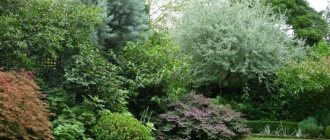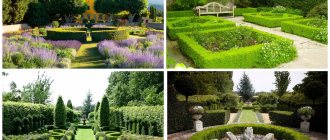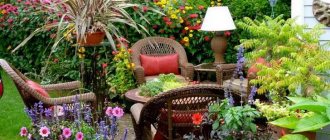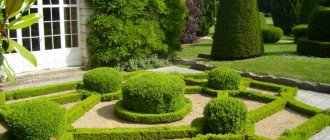History of the style
The English style in landscape design is a revolutionary response to the severity and filigree of the gardens of Versailles of the 16th and 17th centuries. In the British version, it is not man who controls nature, but rather the opposite: nature itself suggests what is better and more correct. You just need to listen to her.
The first informal gardens opened in central England in the early 18th century. They were distinguished by poetic landscapes, smooth structure and delicate palette. The authors of the new style were the artist-architect William Kent and the royal gardener Charles Bridgeman. They were inspired by ancient Roman parks and open air paintings of the Classical era. But they borrowed many details from the gardens of France and Italy.
W. Kent's garden on the Chiswick estate is an example of the English landscape style
By the end of the 18th century, the English landscape style quickly spread throughout Europe, including Russia. Catherine II was delighted with the natural beauty of the landscape, rounded shapes, picturesque ponds and colorful flower beds. As a result, elements of the English garden style incorporated the famous parks of Gatchina, Pavlovsk and Tsarskoe Selo. And today English gardens do not lose their relevance - they are timeless and fashionable.
Shrubs
Shrubs can be of any variety that can and should be trimmed into a certain shape. Beautiful specimens will help create interesting compositions.
Modern florists offer a huge selection of not only species, but also different shades of foliage, almost white, variegated.
Try using antique household items, large baskets and clay pots, and other preserved antiques to create interesting compositions.
The main thing is that everything is harmonious, restrained in color, gentle and elegant. Under no circumstances create a bright floral display. English style implies restraint.
Concept and principles
In its philosophy and aesthetics, the English garden is closer not to wild nature, but to pastoral painting. The gardener’s task is to recreate a luxurious idyllic landscape worthy of classic paintings or collectible postcards. Despite their apparent simplicity, English parks are thought out to the smallest detail, including combinations of shades and halftones, transitions and contrasts.
Important: the English garden was the backdrop for traditional country estates of the 18th and 19th centuries.
Landscape garden surrounding an ancient estate in England
The atmosphere in them is conducive to long leisurely walks, pleasant conversation, reflection and contemplation of nature. The English garden gives the impression of aristocracy, slightly beyond the bounds, but without losing its nobility and sophistication. Although he loves space, it is quite possible to arrange it on the usual six hundred square meters. It is important to adhere to a number of principles:
- Plant abundance (use many different flowers, herbs, trees),
- Unity with nature (predominance of curved lines and natural outlines, decor and finishing made from natural materials),
- Spaciousness (lawns and lawns occupy about 40% of the area),
- Flow (soft smooth boundaries, one flows into another)
- Contrast (combinations of shades, volumes, textures),
- Antiques (vintage furniture, aged surfaces, antique-style decor).
Important: when decorating a garden, prefer natural materials such as wood, stone, ceramics, glass, etc.
Lawns and lawns are essential elements of an English garden.
Inspiration from England
Photo from the archive of Olga Evseeva
Even before moving to the new site, I studied in England, where I fell in love with their discreet natural landscapes. Such landscapes are very stylish and even aristocratic. I don’t like diversity, I’ve always liked a natural garden, so England couldn’t help but inspire me. The image of my new garden did not appear in my head right away; it took several years, but when we acquired a new plot, we already had a clear idea of how I would proceed.
- Top 10 books on site design that are worth reading
It's so nice to read and dream on long winter evenings. We choose books on garden design that will give you new ideas.
Secrets of planning
When planning a site, take into account the features of the landscape. Ideally, it should be hilly, with small hills. Along with an abundance of curves and wavy shapes, you can use a few straight lines to help structure the garden. Create a focal point, such as a bench, statue or tree, that has a direct path leading to it.
Tip : In addition to exploring existing garden options, be inspired by wild landscapes and works of pastoral painting.
Approximate garden plan in an English garden
In advance, add to the plan “viewpoints” from which the panorama of the garden will open. Complete them with a gazebo or patio, bench or sculpture. To maintain an atmosphere of romance and mystery, consider a few hidden spaces (a small corner with a bench behind a high hedge, an unexpected flower bed at the end of the garden).
Tip: Emphasize significant garden objects by freeing up spaces around them, creating paths to them and placing a bench in front of them.
Nook with bench at the back of the garden
Places for rest and contemplation should be located away from the main paths and surrounded by dense greenery. Hide vegetable beds at the edges of the garden, or incorporate them into the landscape with curved, high borders.
Exceptions to the rules
Photo from the archive of Olga Evseeva
The first exception was made about 10 years ago, when I decided to plant blueberries. I knew that she was very demanding, but for the sake of this elixir of youth I was ready to waste my energy. In the end, this berry turned out to be not so capricious, but perhaps the fact that adult bushes were purchased immediately played a big role.
But my experiment with chrysanthemums ended in failure: out of eight bushes, only two survived.
- 10 varieties of garden blueberries that you will definitely love
The most delicious, productive and winter-hardy varieties of highbush blueberries.
Key elements
Abundance of greenery
The English-style cottage is surrounded by greenery. The feeling of density and volume is achieved through dense planting and plants with abundant foliage. Fluffy green lawns are held in high esteem. They are organized in the center of the garden, smoothly connecting with flower beds and hedges. Instead of borders there are flower borders or small structures made of natural stones and wood.
Tip: when choosing plants, consider seasonal decorativeness so that the garden looks aesthetically pleasing at any time of the year.
The classic English garden is always full of greenery
Mixborders are an integral part of English gardens. They make the area voluminous and colorful, conveying a feeling of plant abundance. Flowers can partially extend beyond the boundaries of the flowerbed, emphasizing smooth transitions and unity of garden elements.
Color balance
Colorful flowering plants against a backdrop of lush greenery set the rhythm of the garden palette. Initially, it was dominated by pastel and white shades. Today, not a single English-style garden can do without red, blue, lilac and pink flowers, which are responsible for the soft, romantic atmosphere. Vintage tones are no less attractive: orange, peach, light pink, pale yellow, brown, purple.
Tip : play with contrasts, combining opposite shades (blue - orange, purple - yellow, red - turquoise).
English garden in a delicate vintage palette
Make a bet not on the number of combinations, but on the volume of color. It is enough to mix 3-5 shades and repeat them in lush plantings throughout the area. It is advisable to choose monochrome plants, avoiding unusual, too variegated varieties (rainbow roses, striped irises).
Nature trails
Paths in an English garden are a harmony of naturalness and unpredictability. Most often they are made of paving slabs or natural flat stones with uneven edges. They are laid out on the finished lawn in a free configuration. Near the house and buildings, stick to comfortable straight lines, and in the garden, use looser, curved ones.
Important: durable and aesthetic stones for paths - quartzite, sandstone, quartzite sandstone or shungite.
Gently curved natural stone path
A path made of aged brick with a characteristic texture and patina looks no less impressive. But the easiest way is to sprinkle the paths with gravel, sawdust or stone chips in discreet shades. When drawing up routes, take into account the “effect of surprise” so that it is difficult to immediately guess which element of the garden the path will lead to.
Picturesque pond
It’s hard to imagine an English garden without it. The main condition is that the reservoir should look as natural as possible: without sudden changes in depth, with uneven smooth boundaries and chaotic thickets around. But this does not mean that it should be covered with mud and resemble a swamp. It is necessary to regularly purify the water and maintain its transparency.
Tip: line the banks of reservoirs with large stones and surround them with moisture-loving plants and shrubs.
A pond surrounded by large stones and small pebbles
It is best to locate the pond at the back of the garden behind a hedge wall. It can be decorated with a wooden or stone bridge, a small waterfall, stream or fountain. The style of the decorative elements of the reservoir should fit organically into the natural landscape.
Rest zone
To leisurely admire the beauty of the garden, arrange gazebos on a small hill. Wooden, stone and forged structures in the style of Roman rotundas or Chinese pavilions go well with the English landscape style. Shade and privacy will be provided by hanging plants (climbing roses, morning glory, virgin grapes).
Traditional gazebo in the shade of an English garden
Choose furniture in a vintage or classic style with a slight touch of antiquity. Objects should not blend into the background. Instead of the usual gray and black tones for benches, choose shades that stand out against the green: white, blue, yellow, pink, orange. The result is a dramatic focal point that draws attention to the landscape.
Tip: the colors and materials of garden furniture should be in harmony with the decor and buildings of the garden.
Bench with pergola - additional place to relax in the shade
White corner
Photo from the archive of Olga Evseeva
I have several of them and, perhaps, these are my favorite places in the garden. Here the mood is set by variegated mock orange (Philadelphus coronarius Variegatus), tree hydrangea Sterilis, lilac Beauty of Moscow, Rose Iceberg, aruncus and some other plants. Different shades of white and green create a very delicate landscape, and lilac and mock orange fill this part of the garden with a subtle aroma. The compositions look very sophisticated, and caring for them is very easy.
- White flower garden: 16 best plants for different seasons
Add a little white to your flower garden: plant plants with snow-white flowers in your area.
Decor features
Arches
They will emphasize the smooth rounded lines of the garden, add splendor and become a support for hanging roses and clematis. A whole corridor of several arches, entwined with flowering vines, looks romantic. They are installed closer to the center of the garden, sometimes preceding the entrance to the gazebo. The arch between the hedges is like a door to another “garden room”.
Unusual arches from tree branches
Sculptures
Several sculptural objects in different corners of the site will set the rhythm of the landscape. They are located both in central areas, near benches and gazebos, and in the most unexpected places: under a tree, behind a hedge, inside a grotto, in the thickets of a pond. Antique-style statues and vases, forged or stone birdbaths are a sure way to bring the spirit of antiquity and aristocracy into the garden.
Sculpture surrounded by living borders and flower beds
Pergola
Like an arch, it also serves as a support for flowering vines. But forget about complex large structures with bulky beams. In the English garden, compact wooden pergolas combined with trellises are popular. They are often used instead of arches, preceding the entrance to the main lawn. A good idea is to place them near benches at the back of the garden.
Corridor of pergolas entwined with climbing roses
Video description
The video shows how the English Garden Museum was created in London, where purely English landscape design is presented:
Water sources
In English parks you can find small springs, small fountains, and well-groomed ponds. All of them have high decorative functions, and they can be used for watering plants.
A pond with a stepped waterfall in a luxurious green frame Source yexplore.travel
Solving such elements requires serious material investments. The size of the reservoirs should be impressive, the banks should be high, and the plants should be planted in large groups.
Careful care
A garden in the spirit of good old England should be surrounded by great love. This style is best suited for those who like to tinker with plants: pruning roses, mowing green lawns. Everything needs careful care, you have to put your soul into everything. Therefore, such a creation will not suit lazy people. Even one neglected bush, a withered bud, a dry shoot will immediately destroy the splendor created by your hands. And there can be no talk of weeds. So careful care is another principle of creating English design.
Suitable plants
Trees
The English garden is characterized by spreading deciduous and coniferous trees with an elegant crown of different shades. They create a natural landscape with shaded areas. A good option would be: oak, maple, birch, beech, hornbeam, apple, cherry, willow. For contrast and visual interest, add a few short conifers: spruce, pine, larch.
Deciduous trees with abundant foliage
Lianas
They are not only responsible for the shade in the gazebo, but also help soften the boundaries, disguise the artificial elements of the garden, and emphasize the poetic atmosphere of privacy and romance. Among the climbing plants in English gardens, clematis, wisteria, climbing roses, virgin grapes, ivy, and medicinal jasmine get along well.
Luxurious climbing roses on the pergola
Shrubs
In addition to creating hedges and borders, they often frame the surrounding area and garden buildings. Although topiaries are not the main attraction of the English garden, they can still be used to contrast with hedges. Do not chase the number of varieties - leave the most noble shrubs and those that tolerate the local climate well (lilac, jasmine, hawthorn, viburnum, barberry).
Tip: if you don’t have time to tinker with a flowerbed, plant several bushes of unpretentious and lush hydrangeas instead of flowers.
Mixborders with colorful bushes
Flowers
Noble plants add aristocratic luxury to the English garden. Unconditional favorites are roses, peonies, hydrangeas, dahlias, lilies. Mixes of terry varieties with delicate pink and white shades look most romantic. It is advisable to choose 3-4 main flowers and adjust the rest of the plants in the flowerbed to their shade and shape.
Important: portable flower beds in containers and ceramic vases are relevant for the English garden - place them near the house, gazebo and at the junction of paths.
Rose garden in the center of an English garden
Flowers are planted densely to each other in a “ladder” pattern - from tall species in the background to low ones. To add visual lightness and splendor, dilute them with ornamental grasses of different textures, volumes and heights. They will contrast beautifully with a trimmed lawn and large buds.
Plants for English mixborders:
| Groups | Plant names |
| Perennials | Roses, peonies, dahlias, cosmos, bellflower, astilbe, geranium, lilies, lupine, phlox, tulip, chrysanthemum, mallow, aquilegia, echinacea |
| Annuals | Aster, marigold, sunflower, poppy, godetia, petunia, calendula, snapdragon, foxglove, delphinium, alyssum |
| Ornamental grasses and cereals | Hosta, fern, bunnytail, elymus, miscanthus, short-haired reed grass, reed falaris, feather grass, fescue |
| Fragrant herbs | Sage, mint, lemon balm, lavender, tarragon, savory, rosemary |
Design for a narrow area
Photo from the archive of Olga Evseeva
In order not to disturb the neighbors, we built our tall house in the middle of the plot. This made it even more difficult to arrange the narrow territory: I really didn’t want it to look like a carriage. To achieve this, we had to avoid straight paths where possible. All our plantings are rounded, and the fences are covered with thujas, lilacs, maples and bladderworts. Thus, it was possible to divide the territory into several independent zones.
Photo from the archive of Olga Evseeva
I think using containers is an excellent solution for small spaces. I have Thuja occidentalis Holmstrup, Thuja occidentalis Brabant and Chamaecyparis pisifera Boulevard growing in containers. In April, I put them in a place convenient for me, and in October, along with the pots, I dig them in at the back of the plot.
Photo from the archive of Olga Evseeva
Paniculate low-growing hydrangeas, as well as large-leaved hydrangea Matisse, also look impressive in flowerpots.
I also have a mini-garden in a flowerpot. This way you can grow different crops: from tomatoes to strawberries.
- 14 Best Plants for Outdoor Planters
Unpretentious plants, caring for which will not take much of your time.
Autumn is a time of bright colors
Photo from the archive of Olga Evseeva
My white and green garden only becomes truly vibrant in the fall. Of course, I move away from my favorite color scheme in the summer. This is confirmed by several bright daylilies and pelargoniums. There is a place in the garden for clematis of different shades. But it is in autumn that barberries and cotoneasters change their colors. The garden is greatly transformed, but at the same time retains its naturalness and natural charm.
- Decorative trees and shrubs with beautiful fruits for the autumn garden
14 attractive plants that are most decorative in the fall thanks to their bright fruits.
Aroma is the soul of the garden
Photo from the archive of Olga Evseeva
I really like the smell of jasmine or, as it should be said, mock orange. These white beauties grow throughout the garden, making it fragrant in the summer. In spring, the space is enveloped in a pleasant scent of lilac; I also have several types of it. Two fragrant roses are planted right next to the porch: when the windows are open, their scent can be heard in the house.
- Where and next to what to plant lilacs: 4 ideas for a spectacular flower garden
Don't know in which corner of the garden to plant lilacs? This article will help you choose the right location for your aromatic plant.











